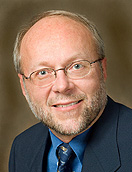News
Advising on health effects of Agent Orange
-
 Print
Print -
 Comments
Comments
-

“We want to inform veterans about the potential risks associated with their service to our country during the Vietnam War.’”
A UB expert on dioxin toxicology has just completed his service on the National Academies Institute of Medicine panel on Veterans and Agent Orange. The panel—the Committee to Review the Health Effects in Vietnam Veterans of Exposure to Herbicides—released its 2010 report last week.
These reports, issued biennially to the Department of Veterans Affairs, help advise officials on policy decisions regarding compensation to veterans for service-related illnesses.
“We do our best to critically look at all the human health data available on the adverse effects of chemicals used during the Vietnam War,” explains James R. Olson, professor of pharmacology and toxicology in the School of Medicine and Biomedical Sciences and of social and preventive medicine in the School of Public health and Health Professions. “We want to inform veterans about the potential risks associated with their service to our country during the Vietnam War.”
Since last fall, Olson and other committee members have conducted an extensive review of the scientific literature published on service-related illnesses and held public hearings with veterans.
“Every year we get more data,” Olson says. He cautions that the committee can consider studies involving diseases and conditions related to Agent Orange exposure as long as they are peer-reviewed.
The committee considered all studies published in a peer-reviewed journal that involved humans exposed to Agent Orange. Many of the studies involved exposures among workers who manufactured Agent Orange at sites throughout the U.S.
Western New York was among the sites where Agent Orange was manufactured and high concentrations of dioxin were found later at sites in Niagara Falls, near the Love Canal neighborhood, which was evacuated in 1978 due to toxic waste seepage.
Dioxin, or TCDD, is an unwanted chemical contaminant that can be generated during the production of herbicides such as Agent Orange, which the U.S. military used as a defoliant in Vietnam from 1962 to 1971.
Olson, who directs the environmental health sciences division in the School of Public Health and Health Professions, says that toxicological studies determined decades ago that dioxin is the most potent known tumor promoter, in addition to being the most potent manmade toxin.
The Veterans Education and Benefits Expansion Act of 2001 mandated that the Veterans and Agent Orange biennial updates continue through 2014.

Reader Comments